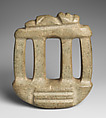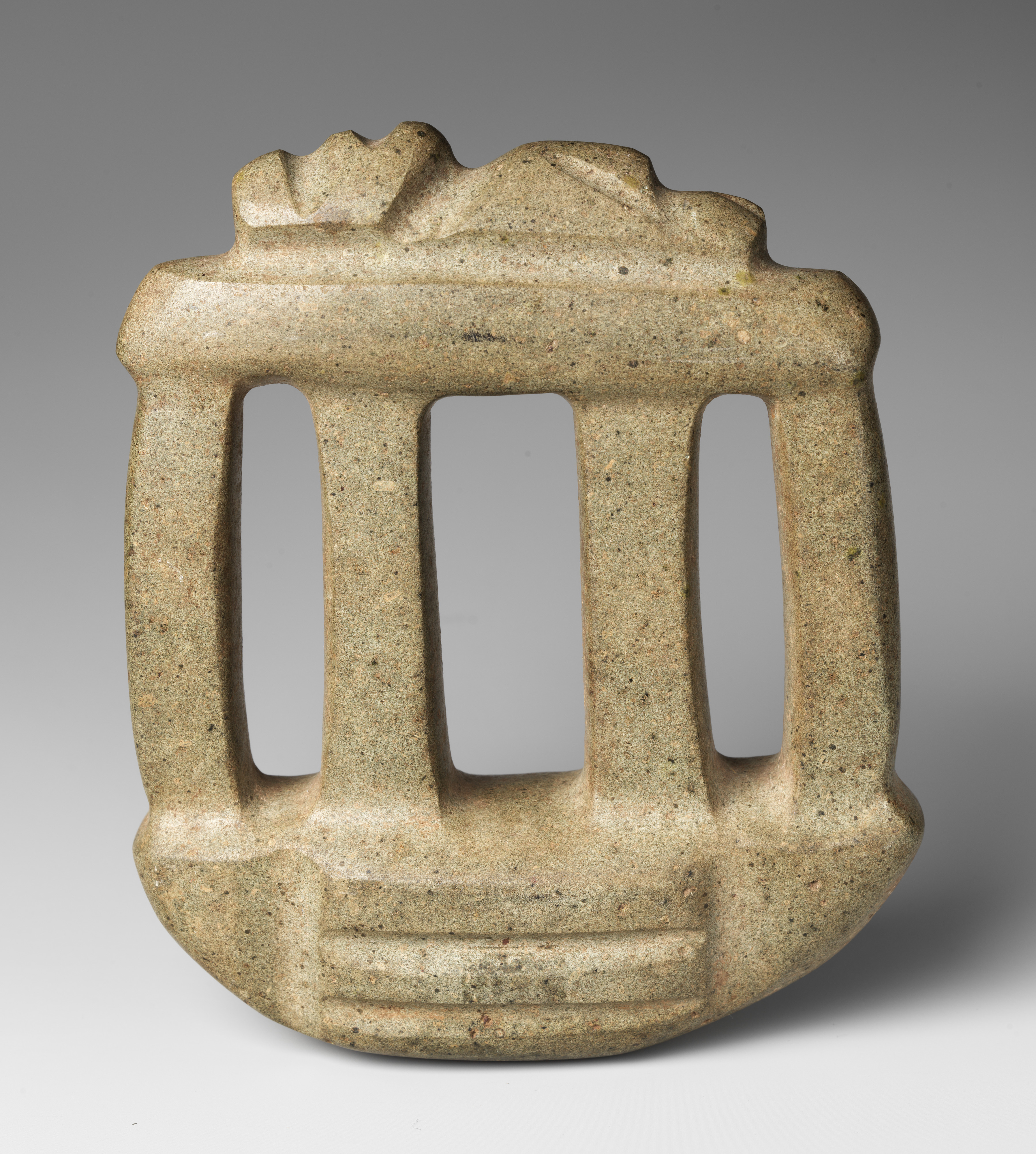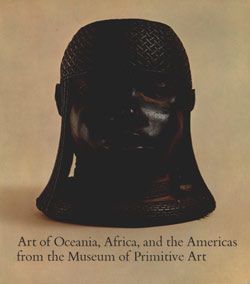Architectural Model with Figure
Not on view
Stone architectural models in the Mezcala style come primarily from the present-day state of Guerrero in southwest Mexico. A particularly long-lived tradition, these works may have been produced over some one thousand years, beginning as early as 500 BCE. Little is known about their archaeological contexts, and there are few points of reference with surviving architecture in the region. It is possible that building models in the form of a colonnade, like this one, reference structures with stone columns, such as those from Cuetlajuchitlán.
Carved from a single piece of greenstone, this rendering favors the two-dimensional, the row of columns representing a façade or entrance which stands for the structure as a whole. Incised lines depict a central staircase on both the front and back. While Mezcala architectural models are generally referred to as temples, it has also been suggested that, when placed in graves, they were meant to serve as entrances into the spirit world or as dwelling places for the deceased (Gay, 1987).
Mezcala models such as this one go beyond depicting buildings to suggest ritual events by including figures, miniaturized versions of the highly abstracted and symmetrical Mezcala stone figurines (see MMA 1978.412.42). Unlike the lively representations of feasting and ritual portrayed in Nayarit ceramics (see MMA1979.206.359) this composition suggests a still and solemn moment. The figure that lies across the roofline may represent a deceased person or sacrificial victim, suggesting that the setting in this example is a temple or other sacred structure, the site of a sacrificial or funerary rite.
Mezcala models may have served multiple functions over time, in keeping with the Mesoamerican custom of repurposing or re-carving stone objects. Those with curved bases like this one may have been re-carved from celts, ritual tools of great symbolic importance. Several others have holes drilled into the base, which could have been used to fasten them with fiber to a larger item such as a ritual bundle, a practice widely known in archaeological and ethnographic contexts in Mesoamerica (see MMA 1994. 35.700). Offerings of Mezcala stone objects in the Templo Mayor, the sacred center of the Aztec capital, Tenochtitlan, built between 1325 and 1519, underscore the importance of these works as a continuation of tradition, as heirlooms, or as emulations of an ancient style.
Further Reading
Arqueología Mexicana, vol XIV, núm 82, El Estado de Guerrero. 2006.
Gay, Carlo T.E. Mezcala Architecture in Miniature. Mémoires de la classe des beaux-arts. Brussels: Académie Royale de Belgique, 1987, pp. 138–9, no. 49.
Gay, Carlo and Frances Pratt. Mezcala: Ancient Stone Sculpture from Guerrero, Mexico. Geneva: Balsas Publications, 1992.
González, Carlos Javier and Bertina Olmedo Vera. Esculturas mezcala en el Templo Mayor. Mexico, D.F.: Instituto Nacional de Antropología e Hostoria: GV Editores: Association de Amigos del Templo Mayor, 1990.
La cultura Mezcala y el Templo Mayor. Mexico, D.F.: Instituto Nacional de Antropología e Historia, 2003.
Pillsbury, Joanne, Patricia Joan Sarro, James Doyle, and Juliet Wiersema. Design for Eternity: Architectural Models from the Ancient Americas. New York: The Metropolitan Museum of Art, 2015, pp. 46–47, fig. 48.
Schávelzon, Daniel. Treinta siglos de imágenes: maquetas y representaciones de arquitectura en México y América Central prehispánica. Buenos Aires: Fundación Centro de Estudios para Políticas Públicas Aplicadas, 2004.
This image cannot be enlarged, viewed at full screen, or downloaded.
This artwork is meant to be viewed from right to left. Scroll left to view more.





